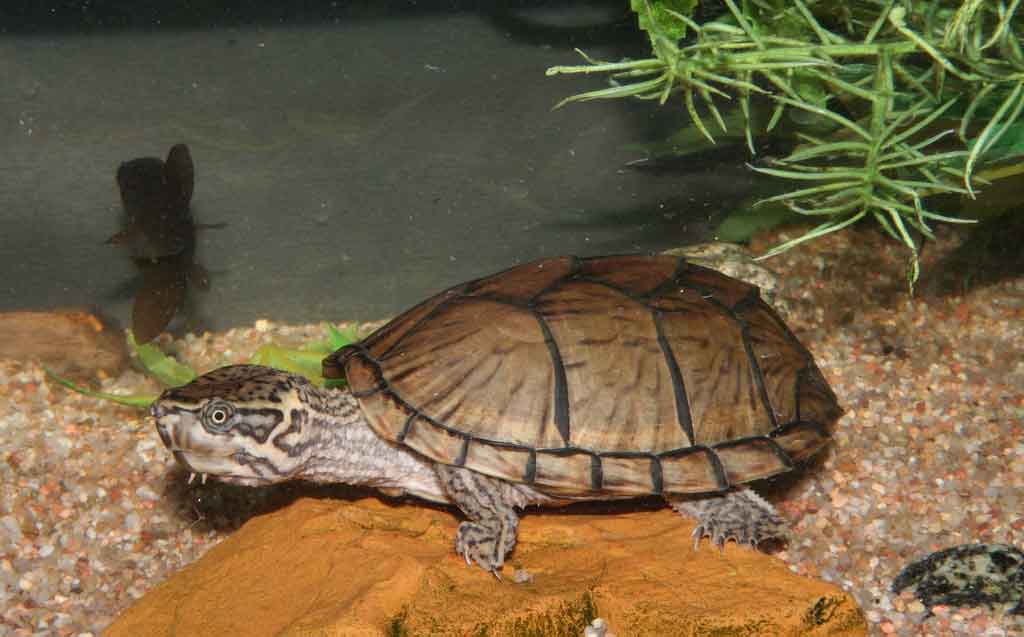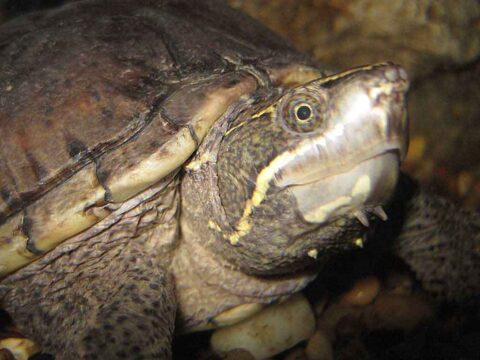
Content |
|---|
Origin / Distribution
The Common musk turtle (Sternotherus odoratus), It has a fairly wide distribution area., extending north into the eastern half of the US. (Illinois, Wisconsin, hasta Maine) and south into southern Canada (Quebec, Ontario) to Florida and west to central Texas.
Characteristics / Appearance
The carapace of adults is dark brown., dark gray to black and has no markings. It is evenly curved, narrow and elongated. In juveniles a pattern of dark spots is visible. Juveniles also have three characteristic keels, that disappear with age.
The plastron is small and cross-shaped. (bikini shell), and the color can range from light beige to full black. In this species, connective tissue sutures are especially prominent.
The head, legs and other soft tissue are light gray to black, although coloration changes with age. On the sides of the head there are two yellow stripes that vary depending on the specimen., one above and one below the eye from the tip of the nose to the neck (sometimes with a connection behind the eye). These stripes can fade or disappear completely with age.. There is a pair of barbels on the chin, sometimes there may be a second pair.
The Common musk turtle can reach a size of 13,7 cm., but in most cases it only measures between 7,5 and 10 cm., and both sexes are about the same size.
Habitat
Inhabits all types of fresh water, like lakes, ponds, rivers, swamps and canals, and prefers slow-moving waters with sandy bottoms. The species prefers shallow water areas. Despite its undemanding character, does not tolerate brackish water.
Behavior
The Common musk turtle belongs to the genus Sternotherus and it looks a lot like Striped mud turtle of the gender Kinosternon at first sight. unlike the turtles Kinosternon, that they can close their abdominal shell with the help of two hinges, the Common musk turtle has a retracted abdominal shell and is not hinged. This makes them more mobile and they compensate for the lack of protection by being more aggressive.. when they are threatened, give off a strong, unpleasant odor, what gives them their name.
The Common musk turtle is active in the morning and at night. Land rides are popular at night. Other species of Sternotherus are more active during the day.
Threats to the species
State of conservation ⓘ |
||
|---|---|---|
 Minor Concern ⓘ
(UICN)ⓘ
Minor Concern ⓘ
(UICN)ⓘ
| ||
Although the Common musk turtle does not have federal conservation status in the US. and is fairly common throughout most of its range, has decreased markedly in some areas, and appears to be more sensitive than some native species to human degradation of wetlands. It is listed as a threatened species in the state of Iowa.. It is listed as an endangered species in Canada., and is protected by the federal Species at Risk Act (SARA). It is also protected under the Ontario Endangered Species Act.. In this part of its range, only wetlands with minimal human impact have robust populations. The mortality of reproductive females on roads can be one of the problems associated with human development.
The "Common musk turtle" in captivity
Aquaterrarium
Depending on the size or age of the Common musk turtle, the aquarium should measure between 80 x 40 cm. and 100 x 50 cm., more space never hurts. The water level should initially be about 5 cm for small pups, the Common musk turtle adult prefers some 30 cm.. Animals like to run through the sandy substrate, but also climb to the surface of the water in the indoor furniture or swim freely in the water. Consequently, exuberant planting and good structuring with root wood or non-slip stones up to the surface must be carried out. Occasionally, turtles use furniture that protrudes from the water to sunbathe, although much less frequently than, for example, the ornamental turtles. Furniture also creates important hiding and resting places..
Females should be offered a sandy, partially planted area of land for egg laying.
Lighting and temperature of the aquaterrarium
A lamp, for example HQI, should hang above to heat the area to 35-40°C. The species also likes to use the area to rest. This species also likes to use the area for nocturnal terrestrial excursions..
During the period of activity, The water needs to reach a temperature of 22 a 26°C, which is why, depending on ambient temperature, a heating rod must be used. A rest phase in winter of about 3 months at about 10°C is suitable for the species and is necessary to keep it healthy in the long term. This value is only indicative due to the large distribution area. Animals from the north of the distribution area have to enter torpor at a water temperature of 4°C – 5°C, animals in southernmost areas hibernate mostly at 10°C – 15°C.
A sufficiently sized filter ensures clear water and serves the health of the turtles..
In the middle of summer, the Common musk turtle can also be kept in secure outdoor enclosures if provided with gently sloping edges and plenty of greenery. But, in these conditions, animals cannot be observed regularly and, Therefore, are difficult to control.
Maintenance of the "Common musk turtle"

The Common musk turtle is a solitary animal, so adult males should generally be kept solitary. It is also recommended to keep females individually.. If two or more females are kept together, aggression and stress among lower animals are very likely, Therefore, close observation is necessary. Then, it may be necessary to separate the animals and set up another tank.
To keep the Common musk turtle as appropriate as possible to the species, we recommend the following conditions.
- air temperature: 25° a 26°C
- Minimum size of the terrarium: 200 litres
Outside maintenance
The Common musk turtle can be kept in a garden pond from May to October. The pond should have a shallow shore and be sunny, as this particular species likes to bask in shallow water. It also, Don't rule out a large, powerful aquarium heater in the event of bad weather and the temperature drops below 10 degrees Celsius for a long period of time. The enclosure must be relatively high, Since the Common musk turtle it is a very good climber; concrete blocks and palisades can be used for this. It is essential that crystals or the like are not used, since of the turtles they will try to cross the transparent barrier constantly.
Food
The Common musk turtle feeds mainly on animal feed, consisting of dry food for turtles, worms, meat and fish strips. But, fruit and salad should also be offered occasionally.
Reproduction
The breeding season is mainly from April to May and from September to October.. Like this, can be put from 2 to 4 clutches of eggs by season. The stalls are usually 1 to 5 eggs, Although they can reach 10 eggs. under natural conditions, The incubation period lasts between 65 and 86 days, but can also reach 107 days in unfavorable cases.
Buy one "Common musk turtle"
The Common musk turtle, by breeding in large numbers on US breeding farms., is frequently and cheaply available commercially. This encourages ill-considered impulse purchases, which means that the number of unwanted animals that are given away is very high.
The price of the "Common musk turtle" in the exotic animal trade ranges from 40 – 70 EUR.
Videos "Common musk turtle"
|
|
|
|---|
Alternative names:
1. Common musk turtle, Eastern musk turtle (English).
2. Tortue musquée, tortue musquée commune (French).
3. Gewöhnliche Moschusschildkröte, Moschusschildkröte (German).
4. Tartaruga Almiscarada Comum, Tartaruga do musgo (Portuguese).
5. "Tortuga almizclada", Tortuga almizclera común (español).
